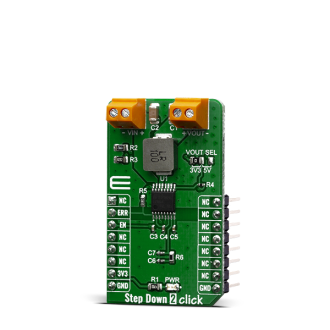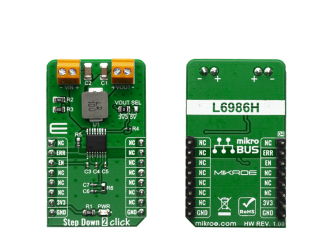
We strongly encourage users to use Package manager for sharing their code on Libstock website, because it boosts your efficiency and leaves the end user with no room for error. [more info]

Rating:
Author: MIKROE
Last Updated: 2020-01-17
Package Version: 1.0.0.0
mikroSDK Library: 1.0.0.0
Category: Buck
Downloaded: 3726 times
Not followed.
License: MIT license
The Step Down 2 click is a Click board equipped with the L6986HTR, a synchronous step-down switching regulator from STMicroelectronics. Because of the main possibilities its features offer, the Step Down 2 click is ideally used for programmable logic controllers (PLCs), decentralized intelligent nodes, sensors, and low noise applications (LNM).
Do you want to subscribe in order to receive notifications regarding "Step Down 2 Click" changes.
Do you want to unsubscribe in order to stop receiving notifications regarding "Step Down 2 Click" changes.
Do you want to report abuse regarding "Step Down 2 Click".


Library Description
The library covers all the necessary functions to control Step Down 2 click board. User can enable or disable the device and check for fault occurrence.
Key functions:
void stepdown2_dev_enable ( uint8_t state ); - Function is used to enable or disable the device.uint8_t stepdown2_check_fault ( ); - Function is used to check whether the the fault has occured.Examples description
The application is composed of three sections :
void application_task ( )
{
if ( stepdown2_check_fault( ) )
{
mikrobus_logWrite( "Device working properly!", _LOG_LINE );
}
else
{
mikrobus_logWrite( "Fault detected!", _LOG_LINE );
}
Delay_ms( 1000 );
mikrobus_logWrite( "--------------------", _LOG_LINE );
}
Other mikroE Libraries used in the example:
Additional notes and informations
Depending on the development board you are using, you may need USB UART click, USB UART 2 click or RS232 click to connect to your PC, for development systems with no UART to USB interface available on the board. The terminal available in all MikroElektronika compilers, or any other terminal application of your choice, can be used to read the message.